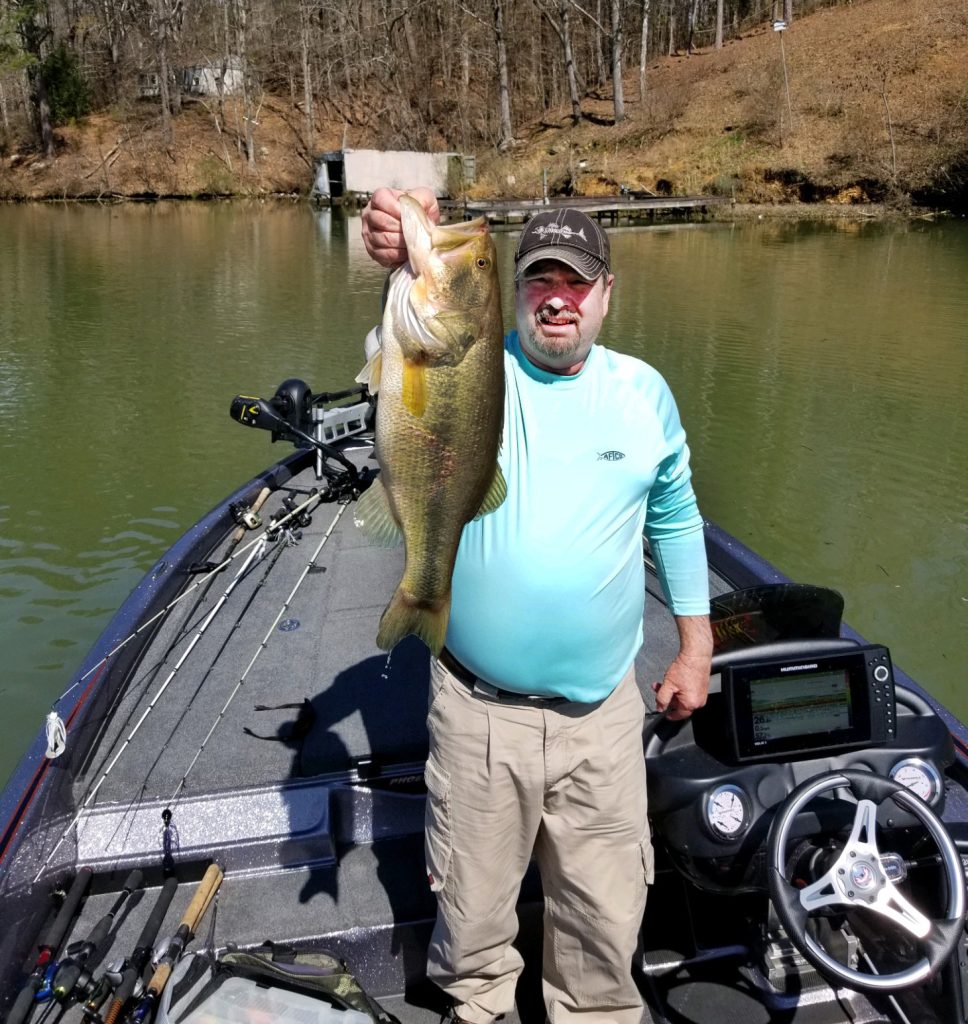Fishing in Tuscaloosa County
Editor’s Note: 27-year-old Jalen Conner is a native of Tuscaloosa and has been fishing in Tuscaloosa County’s Holt Reservoir for eight years. A criminal justice student at Tuscaloosa’s Stillman College, Conner fishes two tournament trails – the S.A.B.A and the Jim Austin.
I like to fish the lower end of Oliver Lake during football season, when the University of Alabama plays its home games because the water in that section of the Black Warrior River tends to be a little-more stained at that time of the year. When most people are either at Alabama football games or deer hunting here in Alabama, my fishing coach and I can catch spotted bass all day long at Oliver. We may be the only boat on that section of the river at that time of the year.
We like to fish the creek mouths in the Moundville section of the Black Warrior River. When currents coming through Oliver Lake in the fall, bass like to hold in the creek mouths at that time of the year. They’ll be feeding on shad and worms being brought to them by the upriver current. We can consistently catch 2–3-pound spotted bass and often even bigger spotted bass in the fall at Oliver.
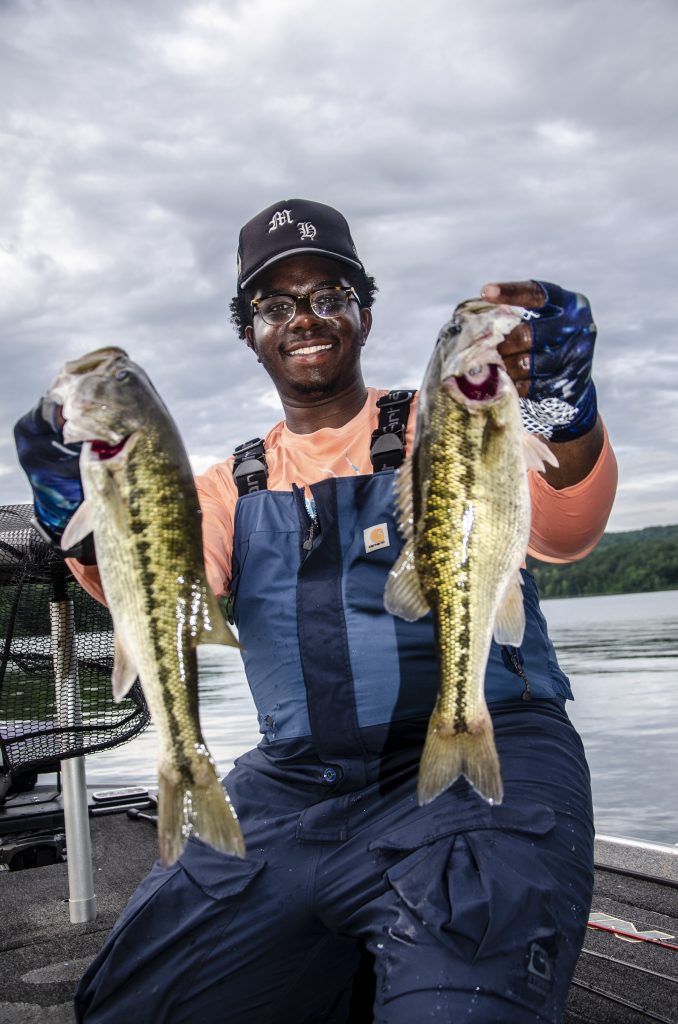
Fishing in Tuscaloosa County
Editor’s Note: 34-year-old Adam Hollingsworth is the President of the University of Alabama Fishing Team and explains, “I went back to college because I spent the first years of my life after high school in the military and as a police officer and eventually wanted to become a U.S. Marshal. I currently have a degree in criminology and plan to start my master’s degree at the University of Alabama in the fall of 2022.”
When it comes to fishing in Tuscaloosa County, to catch summertime bass at Tuscaloosa County’s Holt Reservoir, my primary lure is a Megabass Ito Vision 110+1 Jerkbait in a GP Pro Blue II color that I keep on my rod almost all year long. I’ll be constantly casting and retrieving. This jerkbait runs about 10-15 feet deep, and I’ll use a jerk-jerk-pause type of retrieve and keep the bait moving, until I get a strike. That tells me what cadence the bass want and whether they’ll attack while the lure is moving or sitting still. I’ll work this lure on an iRod Genesis II jerkbait-exclusive rod that’s a medium-action 6’10” long rod. It has a soft tip that helps give the bass a little more of the lure when the bass is jumping and shaking the bait. My reel is a Lew’s HyperMag reel with an 8.3:1 gear ratio, and my line is 10-pound Seaguar Tatsu.
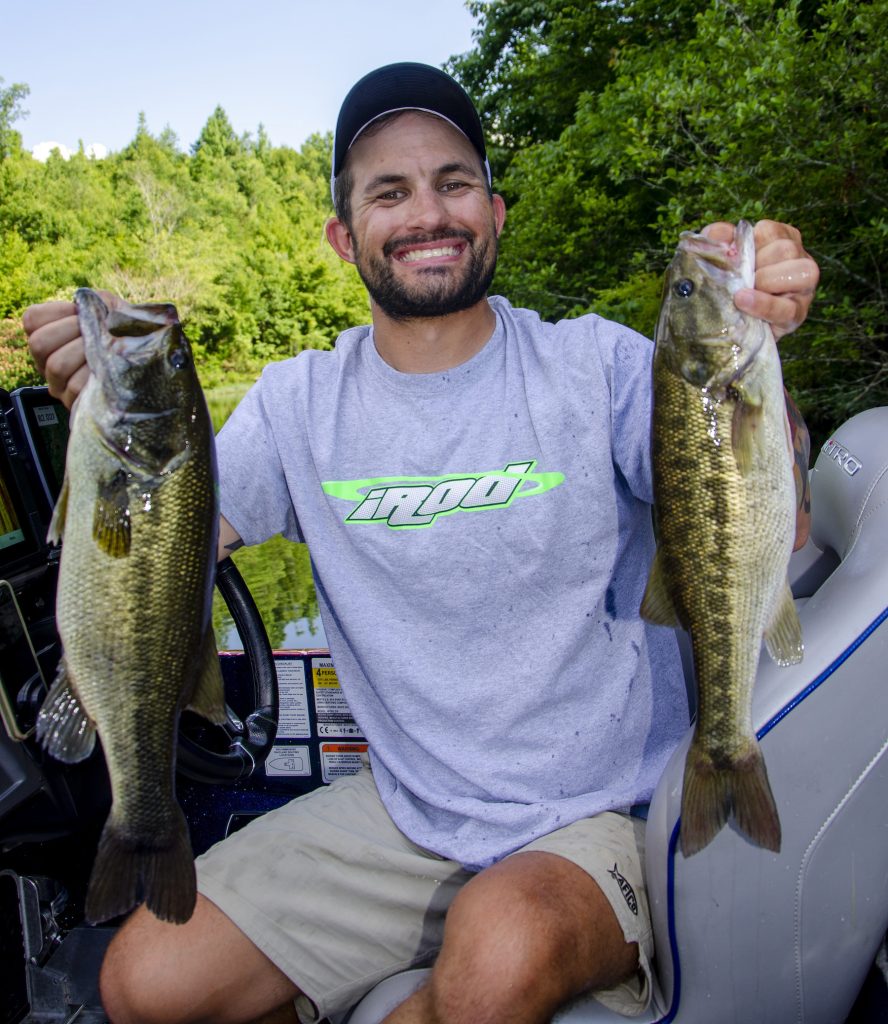
Another of my favorite lures is the Jackal Gavacho in a gill pattern. Since the bluegill are spawning during the summertime in shallow water, you’ll see this bait I’m holding has numbers of bass teeth marks on it. I’ll fish this lure with an iRod Croaker Crusher series, a technique-specific rod, 7’8” long that’s heavy action. I’ll pair that with Lew’s HyperMag 7.5:1 gear ratio reel. So, if I hook into a 5-pound bass, I can winch it out of the cover. I’ll fish with 50-pound test Power Pro braided line and tie the braid straight to the lure. I don’t use a fluorocarbon leader.
I’ll also fish in Tuscaloosa County in the summer at Holt with a Megabass Uoze Swim Jig with a 3/8-ounce head. If I’m fishing another lake somewhere with bigger bass, I’ll use a 1/2-ounce head. I put a Rattlin’ Chunk from Googan Squad and sometimes a Googan Squad Krackin’ Craw as a trailer on this lure. I like the iRod Genesis III that’s a stone-cold swim-and-vibrating jig rod. At Holt, I’ve caught bass weighing 5+ pounds, while using this set-up. My line is 20-pound-test Seaguar Tatsu, and my reel is a Lew’s HyperMag with a 7.5:1 gear ratio. I fish lures in a bluegill pattern, since bluegills are spawning in the shallows during the summer months. I’ll cast the Megabass Uoze Swim Jig right up against the bank in the summer. If the grass is scattered, I’ll do what’s called an “Alabama Shake,” as I retrieve the bait. I’ll also use this same lure on a steady retrieve because the lure has legs that kick as you retrieve it. This lure has a spinner on it, and I’ve caught bass with and without the spinner.
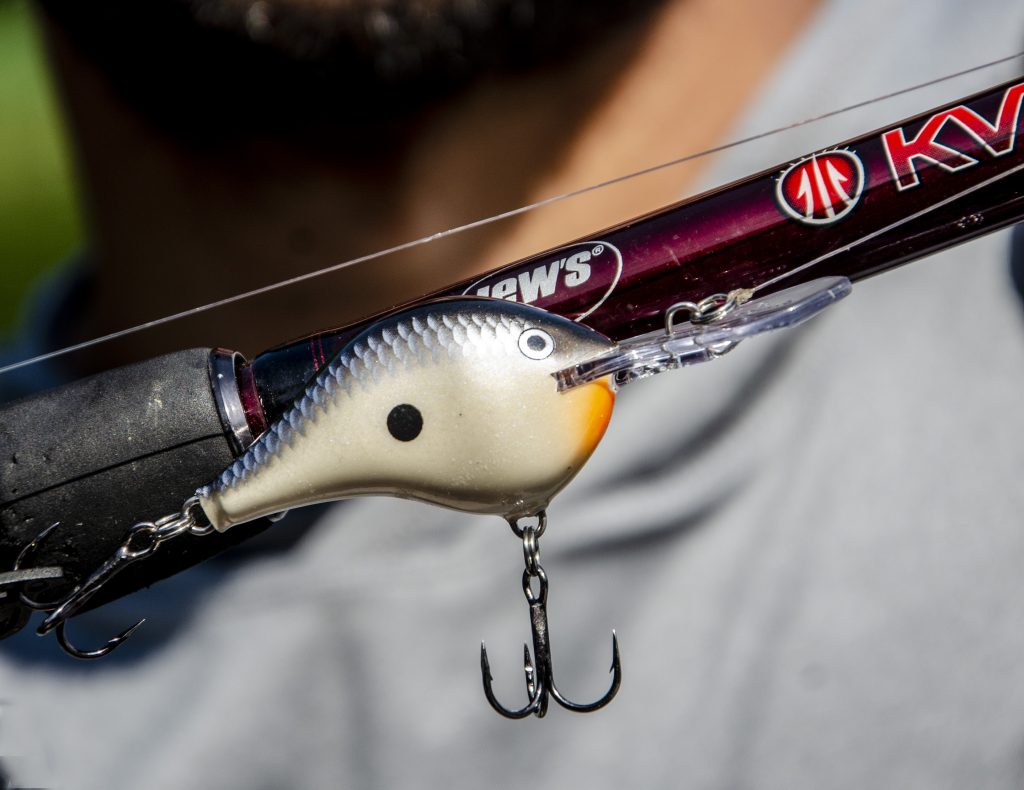
When I’m fishing in Tuscaloosa County deep in the summertime, I’ll use the Rapala DT 8 that goes down further than 8-feet deep – sometimes to 12 feet when I fish it on 12-pound test Yozuri Hybrid Copolymer line. The color pattern is the Ike’s Custom Penguin color. My rod will be the KVD 7’4” long, medium-heavy, moderate-action, made by Lew’s. I also like Lew’s Tournament MP Baitcasting Reel with a 6.8:1 gear ratio.
I like the shakey head jig and the drop shot rig that I fish on a medium-action, 7’1” iRod Genesis III Finesse fishing rod. I’ll also fish a Zoom Baby Brush Hog and dip the tail in chartreuse dye with garlic in it. Sometimes I’ll fish the Baby Brush Hog with a steady retrieve, and other times I’ll let it fall to the bottom and use a steady retrieve, while waiting for the bass to grab hold of it. I feel like I always can pick up this lure and start catching bass with it.
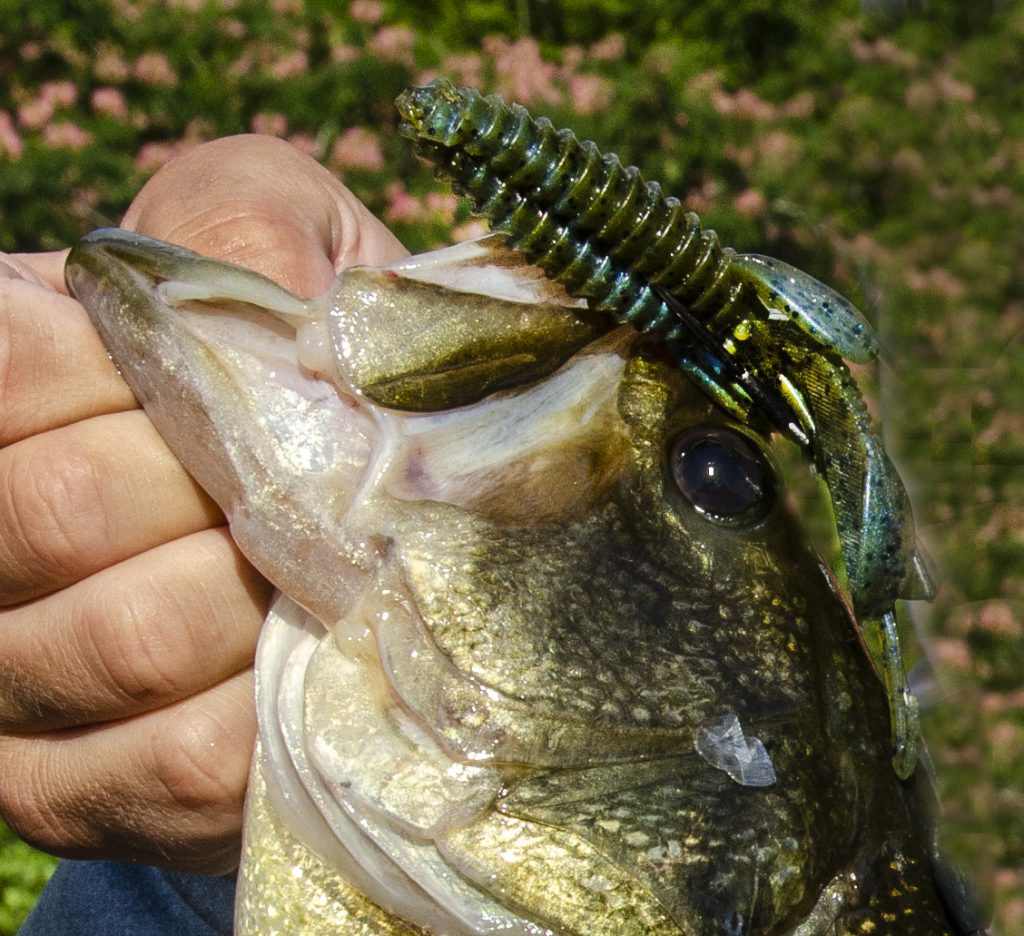
Editor’s Note: D.J. McEachern and his wife, Emily are working toward their PhDs in chemistry at the University of Alabama. D.J. has been bass fishing for 20 years and just recently joined the University of Alabama’s Fishing Team. He’s been fishing in Tuscaloosa County Holt Reservoir on the Black Warrior River in Tuscaloosa, Ala., for the last three years and catches bass from below Lock 17 all the way down to Holt Lock and Dam. He primarily likes to fish grass in the summertime for bass because grass will give bass good ambush points, shade and oxygen.
While discussing lures, McEachern shared: “I create my own 1/2-ounce jigs. I buy my jig heads online. I keep combining different colors of skirt material I like, until I get the color of jig I want. The jig in this picture is similar to one that Dirty Jigs makes named Dirty Craws. But I put more-brown strands in my skirt with some watermelon-colored strands. Strike King’s Rodent in green pumpkin is my favorite flipping bait. I use 3/0 Owner Jungle Hooks with a 5/8-ounce tungsten weight in front of the bait. I like to use this lure when I’m flipping willow grass, and there’s a lot of it on this lake.
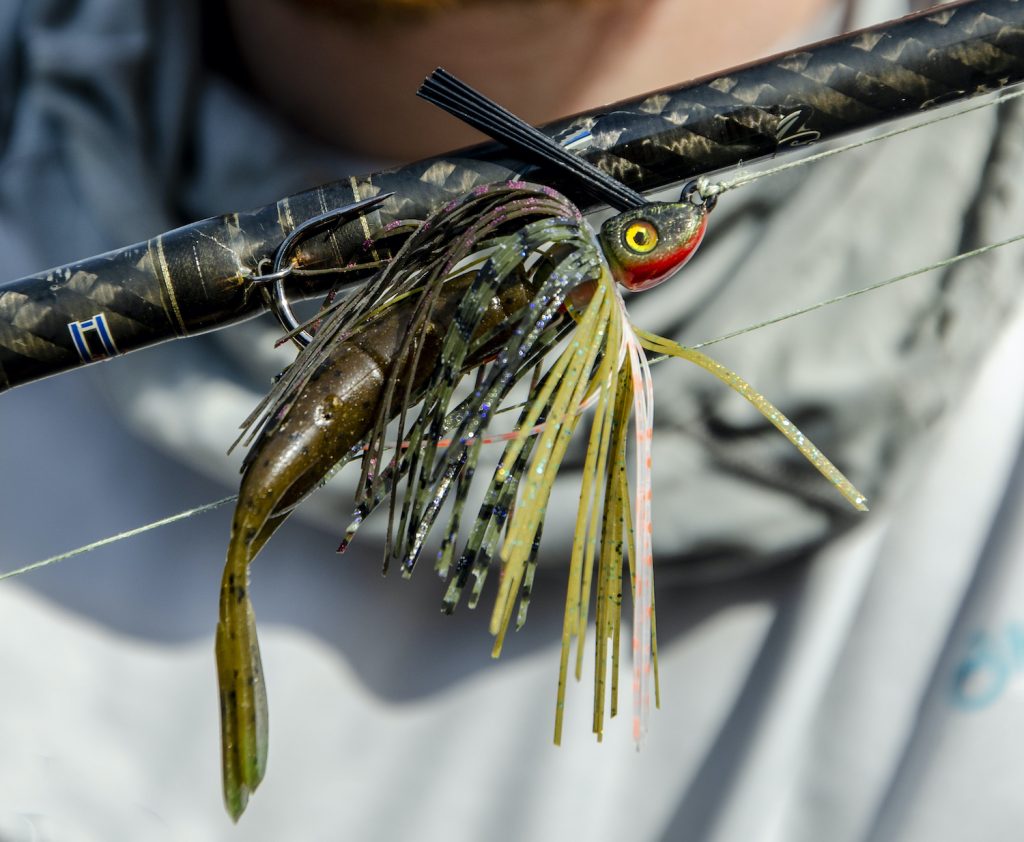
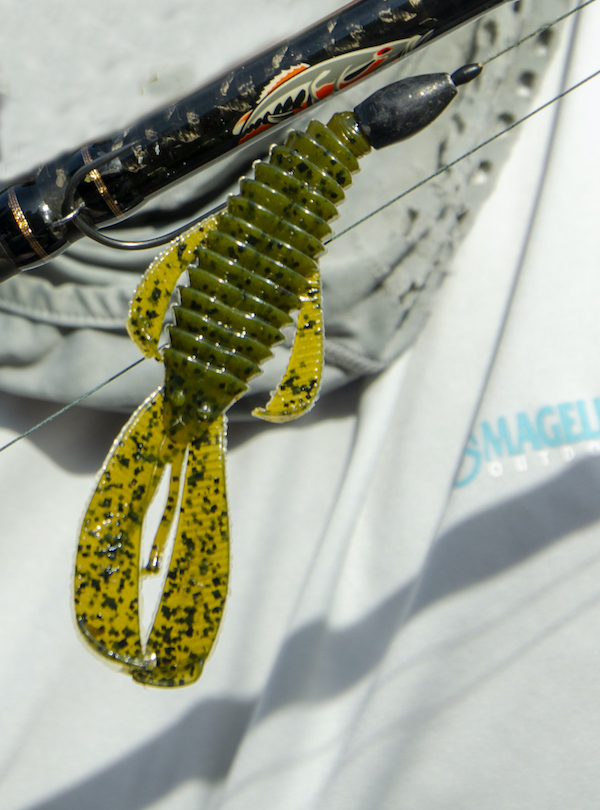
Another lure I like is the Jackall Gavacho Frog. In addition, I like a swim jig made by Strike King that I attach a Speed Craw trailer to with its legs dyed chartreuse. I also like a Berkley Bullet Pop in the ghost gill color.
I mainly fish using the flipping technique because my rod, reel and line have the power to pull a big bass out of the grass, and I’m comfortable flipping. I even flip the Gavacho Frog in the open grass. Flipping is the only technique that I’ve won a tournament with while fishing with the University of Alabama Fishing Team. I won that tournament on Lay Lake. Because bass are cold blooded, when the air temperature is hot on the lake, then the shallow water is also warm, which speeds-up the bass’s metabolism and requires them to eat more than bass holding in cool, deep water.”
If you’re looking to fish in Tuscaloosa County during the summer months, there are always bass to be caught at Holt – shallow and deep – regardless of where you’re fishing on the lake!
With Outdoor Writer, John E. Phillips, and Jalen Conner
Editor’s Note: 27-year-old Jalen Conner is a native of Tuscaloosa and has been fishing Tuscaloosa County’s Holt Reservoir for eight years. A criminal justice student at Tuscaloosa’s Stillman College, Conner fishes two tournament trails – the S.A.B.A and the Jim Austin.
Jalen Conner and I went fishing upriver from Rock Quarry Boat Ramp (more info here) on Holt Reservoir in Tuscaloosa County, Alabama, in early June. From 7:00 am to noon, we caught 10 bass and probably missed twice as many, with the biggest bass weighing about 4 pounds. While that bass was in the live well, it spit-out a crawfish it just recently had been eating. This clued Jalen into the fact that a soft-plastic Zoom Z-Craw was exactly the right bait for the bass we wanted to catch.
“The crawfish color I fish, as well as what most anglers fish on Holt Reservoir, is the Alabama Craw,” Conner explains. “Its main body is orange, and its pincers are red. During the summer months, the Zoom Z-Craw in the Alabama Craw color is the exact color of the crawfish here at Holt at that time. The crawfish will be in the grass, so when the currents aren’t running, or the current’s light, the bass will move into the grass to feed on the crawfish. However, they’ll eat crawfish almost every day during the summer.”
Another color of the Z-Craw that Conner fishes in the summertime is a watermelon red. He dyes the pincers with chartreuse dye. Conner fishes two types of the Zoom Z-Craw – the Junior and the larger Zoom Craw.
“I don’t tell the bass what size of crawfish they want to eat,” Conner explains. “I’ll flip both sizes and colors down the bank and in the grass. Whichever-size Craw gets the most bites is the one I’ll continue to fish. I think the bigger Z-Craw causes a reaction strike from the nearby bass, and that’s why it receives more bites than other baits do.”
Conner went on to explain: “When I’m fishing the Z-Craw, I’ll rig it Texas-style with a Gamakatsu 3/0 hook with a 3/8-ounce tungsten bullet weight in front of it. I then peg the weight to the eye of the hook. Although the Junior and the larger Z-Craws in the Alabama Craw and the watermelon red are my favorite colors, I’ll also fish a purple Craw that looks like a small bluegill. Bluegills and crawfish are what the bass are primarily feeding on in the grass and on the bank structure in the summer at Holt.”
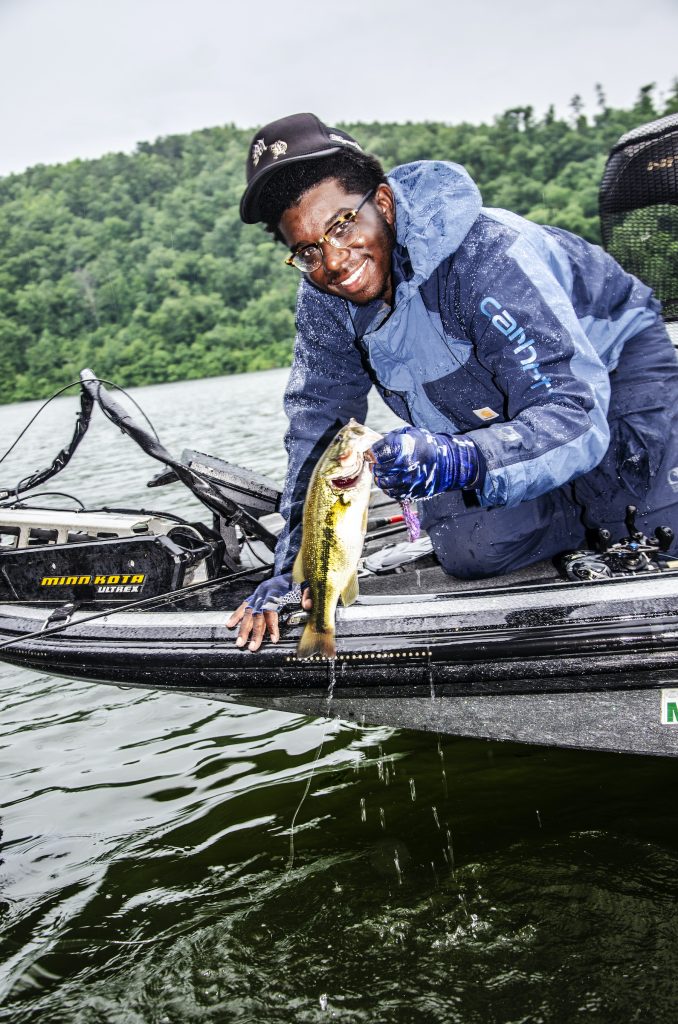
D.J. McEachern: Fishing in Tuscaloosa County at Holt Reservoir
Editor’s Note: D.J. McEachern and his wife, Emily are working toward their PhDs in chemistry at the University of Alabama. D.J. has been bass fishing for 20 years and just recently has joined the University of Alabama’s Fishing Team. He’s been fishing in Tuscaloosa County’s Holt Reservoir on the Black Warrior River in Tuscaloosa for the last three years and catches bass from below Lock 17 all the way down to Holt Lock and Dam. He primarily likes to fish grass in the summertime for bass because grass will give bass good ambush points, shade and oxygen.

“During the summer, Holt Reservoir has a good bluegill spawn, and I don’t believe many people who fish Holt Reservoir flip grass as much as I do. My favorite lures to fish during the hot summer months, all the way through August, include a bluegill popper, like a Berkley Bullet Pop. I also like a flipping bait like the Reaction Innovations Kinky Beaver in the green-pumpkin color that’s 3-1/2 inches long and features flappy tails. I’ll be fishing with 25-pound-test braided line made by Sunline and I don’t use any leader, just a straight braid. I’ll also fish with a Doybns DX795 Champion Extreme, 7’9” flipping rod with a Shimano Curado spinning reel.”
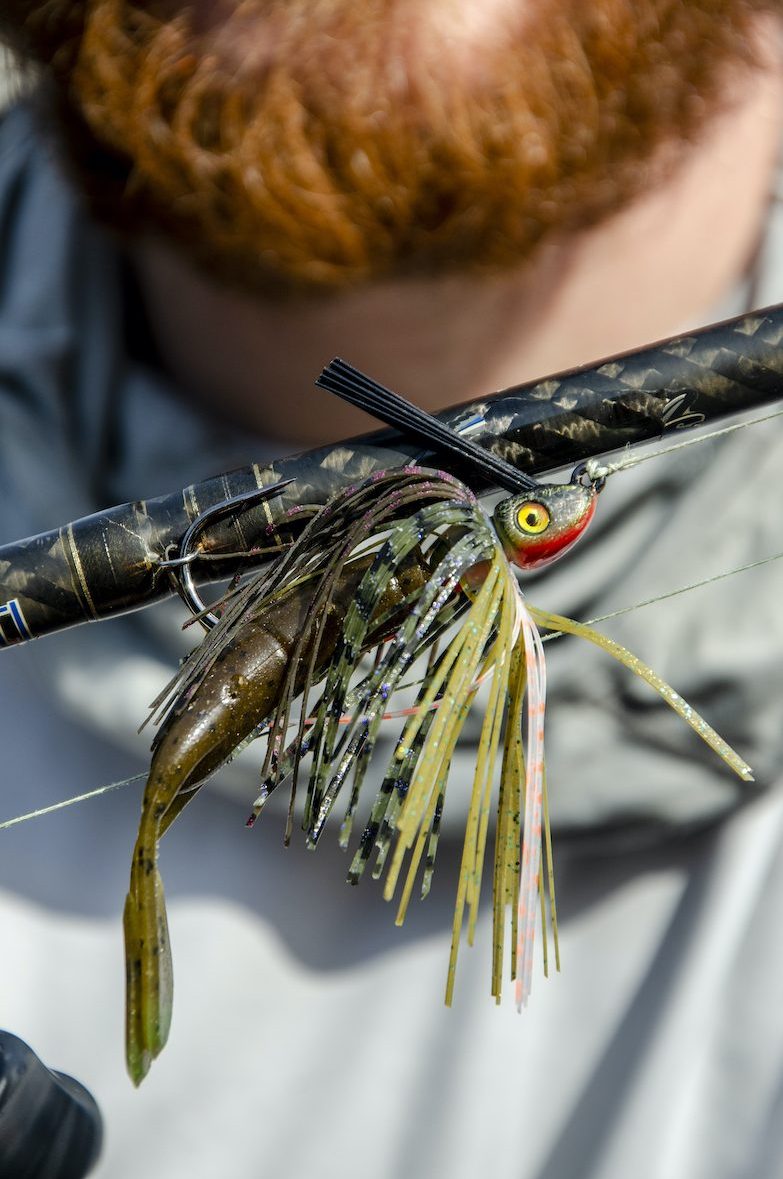
In speaking with McEachern, he catches most of his bass during the summer months near the Lock 15 boat ramp since there’s plenty of grass there on underwater humps, islands and ledges that he can flip.
“I’m known as a bank beater. I like shallow-water fishing for bass better than offshore in the summer months because the bass don’t have to come up through any other atmosphere other than the water depth where they are living. Not having to bring the bass up from deep water isn’t as stressful for them, and they easily can be released and will survive – even on the hottest days.”
Since he knows bass like to feed on bluegills, and almost always there are bluegills in shallow water in the summer at Holt, the shallow-water bass usually bite better than deep-water fish. Of course, a bass in shallow water has to be big enough to get a bluegill in its mouth and eat it, and often will be bigger than deep-water bass in the summertime.
Largemouth Bass Vs. Spotted Bass in the Summer:
“I’d rather catch largemouth than spotted bass. Largemouths are usually the species of bass holding in the grass and shallow water in the summer months. However, my best day of fishing at Holt was in March, 2022. My best five bass there were spotted bass that weighed a total of 20 pounds. I’ve had a lot of days when I’ve caught 15-18 pounds of bass at Holt for a five-fish limit. On an average day, I’ll catch 15-20 small bass. However, I’ve even heard of people catching 10-pound bass out of Holt. For me, a big river bass weighs 4-5 pounds. I try to bass fish two days a week – regardless of the weather or water conditions. But a caution to anyone fishing in Tuscaloosa County and the Holt reservoir is to watch out for logs and other floating trash, especially after a rain.”
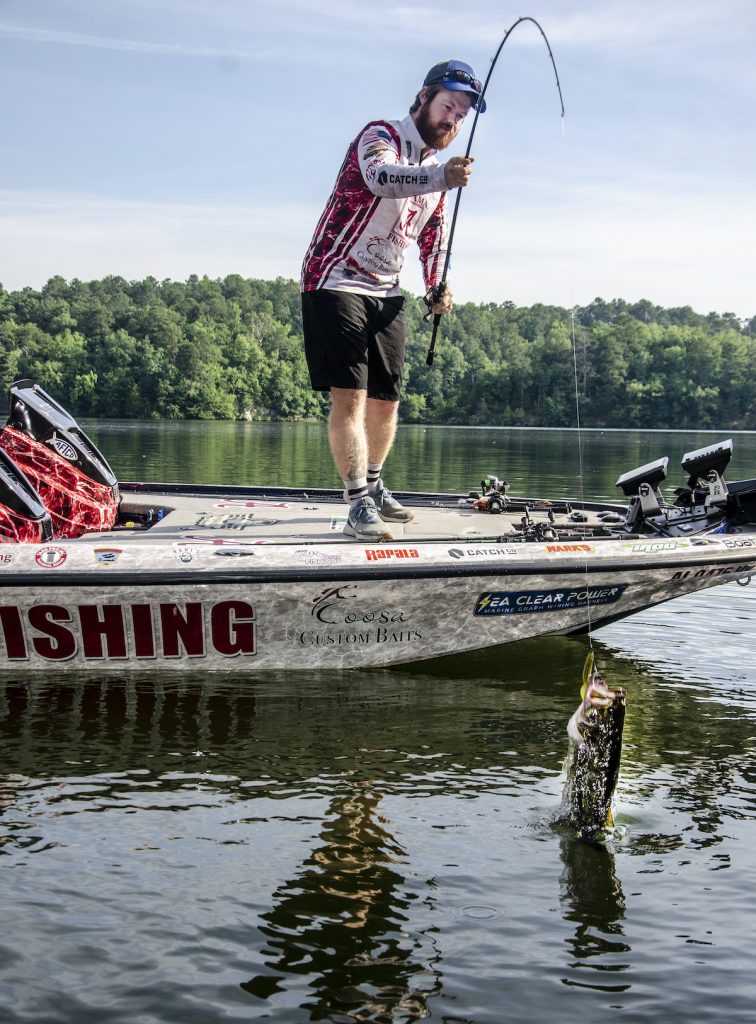
Editor’s Note: 27-year-old Jalen Conner is a native of Tuscaloosa and has been fishing in Tuscaloosa County’s Holt Reservoir for eight years. A criminal justice student at Tuscaloosa’s Stillman College, Conner fishes two tournament trails – the S.A.B.A. and the Jim Austin.
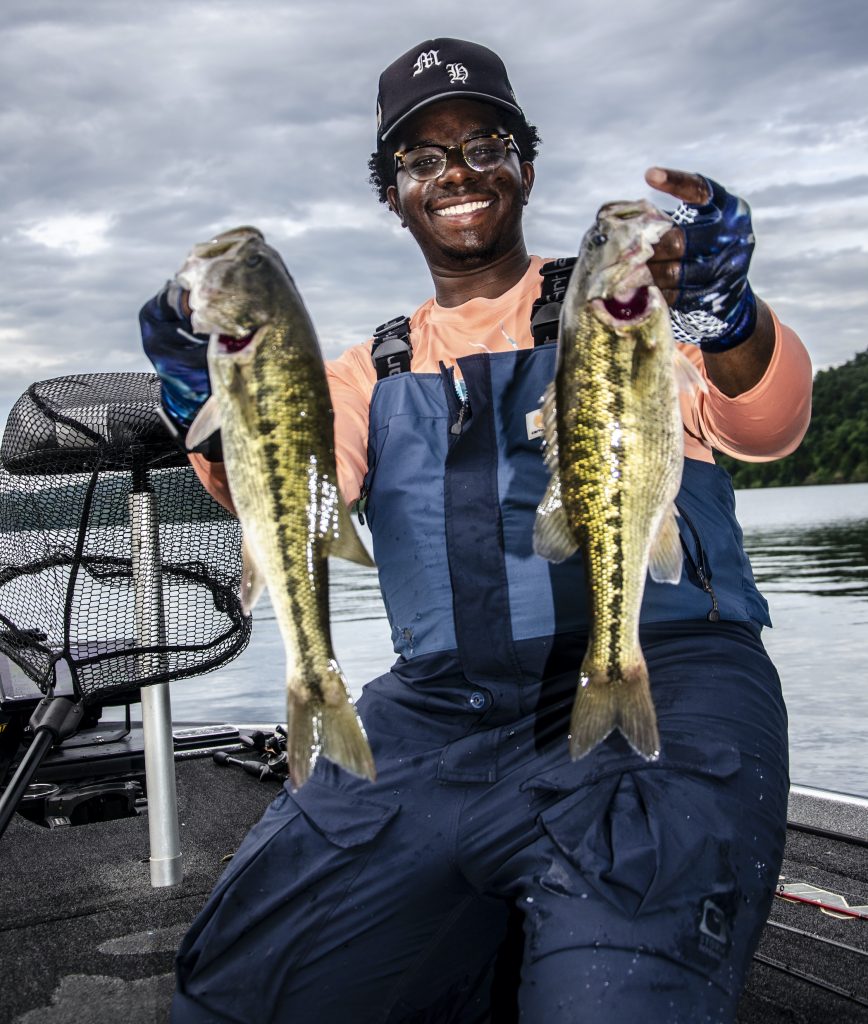
Fish the Bankhead Tailrace to Catch a Wide Variety of Fish:
When fishing in Tuscaloosa County, according to Conner, “When only the generators are running at Bankhead Lock and Dam, you can catch a wide variety of fish in the tailrace, including saltwater stripers, hybrid striped bass, white bass, catfish and crappie. I’ve seen a 65-pound blue catfish that was caught in that tailrace, and the tailrace homes plenty of eating-size cats too. I’ve also had some friends who have limited out quickly on catching crappie in the tailrace because they know where the eddy holes are, and the places where the crappie hold when the current’s running.
Lock 17 Dam is the Bankhead tailrace border between Tuscaloosa County to the south and Walker County to the north. Numbers of spotted bass are in this tailrace when the current’s running, especially when the floodgates are open and the power-generating plant is producing current at the same time. Depending on how much current is moving through the lake, the lake may be 3-4 feet high above normal pool. Once there’s little or no current being released by Bankhead Dam, Holt Lake may be 3-4 feet below normal pool. When the current’s running strong, and I want to catch largemouths, I’ll go further downstream and fish mainly grass and bank cover.”
Fish Holt Lake with Jalen Conner and Outdoor Writer John E. Phillips:
The weatherman had promised a 50% chance of rain when Jalen Conner and I had set a date to fish Holt Reservoir. Because we both realized that the weatherman could be 50% wrong, we decided to go ahead and fish and carried our rain suits with us. We were fishing on the first Thursday in June, 2022. Although we ran almost the entire 20-mile stretch of the reservoir from Bankhead Dam to Holt Dam, we only saw three or four boats all day, with only one boat having a fisherman in it. We put in at Rock Quarry Landing with its boat ramps, restroom facilities and parking (more info here) and went upriver first.
During the summer months, Conner believes that the best fishing is upriver.
“Another advantage we have when we fish this section of the river during the week is that we rarely, if ever, see jet skis or people water skiing. This section of the Black Warrior River in Tuscaloosa County is unknown to most Alabama anglers. If you enjoy fishing for bass in a river with plenty of grass, points, sandbars, quality backwater and pocket areas and underwater humps as well as islands and ledges in the middle of the river, then Holt Reservoir on the Black Warrior River near Tuscaloosa, is a hidden gem for you to bass fish.”
This section of the Black Warrior River runs through some of the most-rural areas in Tuscaloosa County and receives little or no publicity. So, the fishing pressure is almost nonexistent during the week there.
Tuscaloosa, AL – Tuscaloosa Tourism and Sports (TTS) has partnered with the Bama-Q Grilling Series to host Grilling in T-Town on Saturday, July 9th at Druid City Social as an official Steak Cookoff Association (SCA) competition. With the goal of creating more opportunities for family-friendly events that unite the community through food sport, TTS is working with local private chef and traveling food judge Alison Hudnall and experienced food sport promoters, Alabama Coasting and Bama-Q productions, to bring this SCA sanctioned event to Downtown Tuscaloosa.
Admission is free to the public and guests will enjoy food trucks, a sampling tent, local vendors, cold drinks, live music, and a family-friendly atmosphere.
This SCA-sanctioned event and World Food Championship qualifier invites top-tier traveling competitors as a way to promote food sport tourism to the City of Tuscaloosa. Local businesses, organizations, and amateur backyard cooks are invited and encouraged to register to compete as well. The top-performing locals will be recognized and eligible to win special prize packs. The competition will also feature a World Food Championships qualifying event with the best dessert taking home a golden ticket to the World Food Championships Finals in Dallas.
To ensure a level playing field, all steaks for the competition are provided by local sponsor Northriver Cattle Co. and are included in the competitor registration fee. Judging will be completely blind.
Food sport has become a new American pastime. As food sport has grown, various sanctioning bodies have emerged across a large range of cooking styles, methodologies, and categories of food. KCBS, FBA, MBN, IBCA, SCA, PNWBA, WFC are just a few sanctioning bodies that offer both seasoned chefs and everyday cooks a chance to take home a win. With cash prizes up for grabs, many have turned to food sport as a way to monetize a hobby. Each sanctioned competition offers up another opportunity for any competitor to land themselves a spot on a national stage.
Learn more about the SCA format and rules by visiting https://www.grillinttown.com or by contacting David Calametti. Click here for the SCA registration link.
As we continue to raise awareness around the opportunities to fish in Tuscaloosa County, especially along the Black Warrior River, Toby Wilson continues to share his advice and expertise.
Editor’s Note: Toby Wilson is a management consultant and has been fishing the Black Warrior River in Tuscaloosa County for the last seven years. He’s also heavily involved with high-school bass fishing in Tuscaloosa County with his three sons through Holy Spirit High School. His eldest, Garrett, is 18-years old, his son, Matthew is 16 years old, and his youngest son, Chase, is 15-years old.
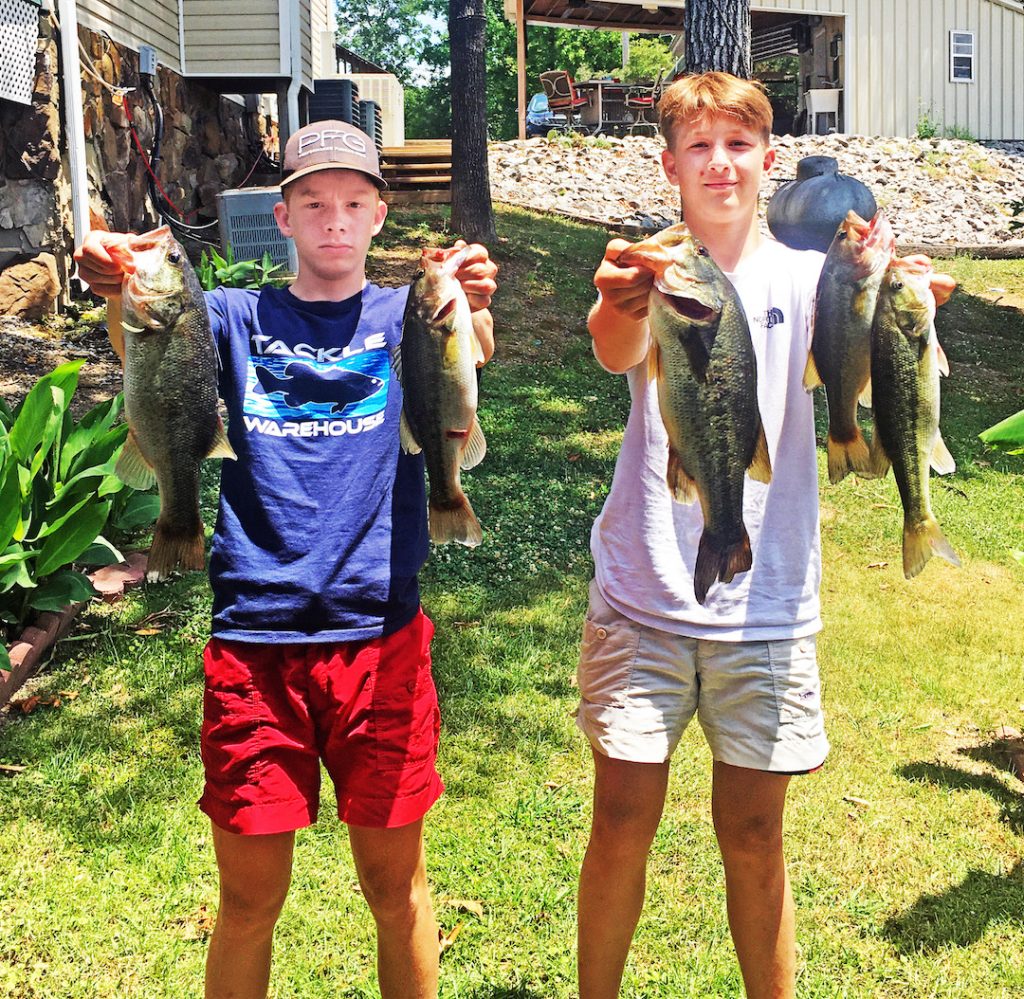
Toby Wilson: I have two sons who bass fish on the high-school circuit. I’ve been the coach for the Holy Spirit High School fishing team for almost six years. This year we have two people on the team, but we have had three before. I’m working on teaching the team how to fish well enough to move into the college circuits. But like most youngsters, they’d rather me take them places where I know bass are there to catch, rather than finding the bass themselves. My son Garrett already has reached-out to the fishing coach for the University of Alabama Fishing Team and will start there in the fall. I’m planning to help both of my sons to bass fish when they go to college too. I have two bass boats – one that was my dad’s boat, and the other is mine.
John E. Phillips: Toby, if someone wants to fish in Tuscaloosa County on the Black Warrior River that runs the length of the county, where can they go to get the best information on tournament results, available fishing tournaments and high school and college programs?
Wilson: Check out Bob Hale’s L&L Marine website. Bob keeps up with most of the tournaments in this area. Dustin Wright, the fishing coach for Tuscaloosa County Northside High School and the District Director for the Alabama Bass Nation, has information on tournaments located in Tuscaloosa too.
Phillips: To fish the Black Warrior River in Tuscaloosa County to catch bass, where and how will you fish, what lures will you use, and what strategies will you employ to produce the five-fish limit needed to be competitive in a tournament?
Wilson: In the spring of the year, the backwater areas that we have available to fish for bass can be very productive. These same regions may not be accessible in the winter, but in the spring and early summer, this section of the Warrior River has a lot of high water that gives anglers access to the backwaters that perhaps we can’t fish during other times of the year.
When I want to fish in Tuscaloosa County, some of my favorite backwaters are in Oliver Lake, all the way down to Lock 6. There seems to be better backwater fishing near the town of Akron and Lock 8 than there is up toward the northern portion of Oliver. Many of these backwaters don’t even have names. Because of the high water, you can find stained water in these backwater regions. The lures that work the best there for bass are lures that make a noise, like the chatterbait and the square bill crankbait. The most-productive color generally is white in both the chatterbait and the crankbait.
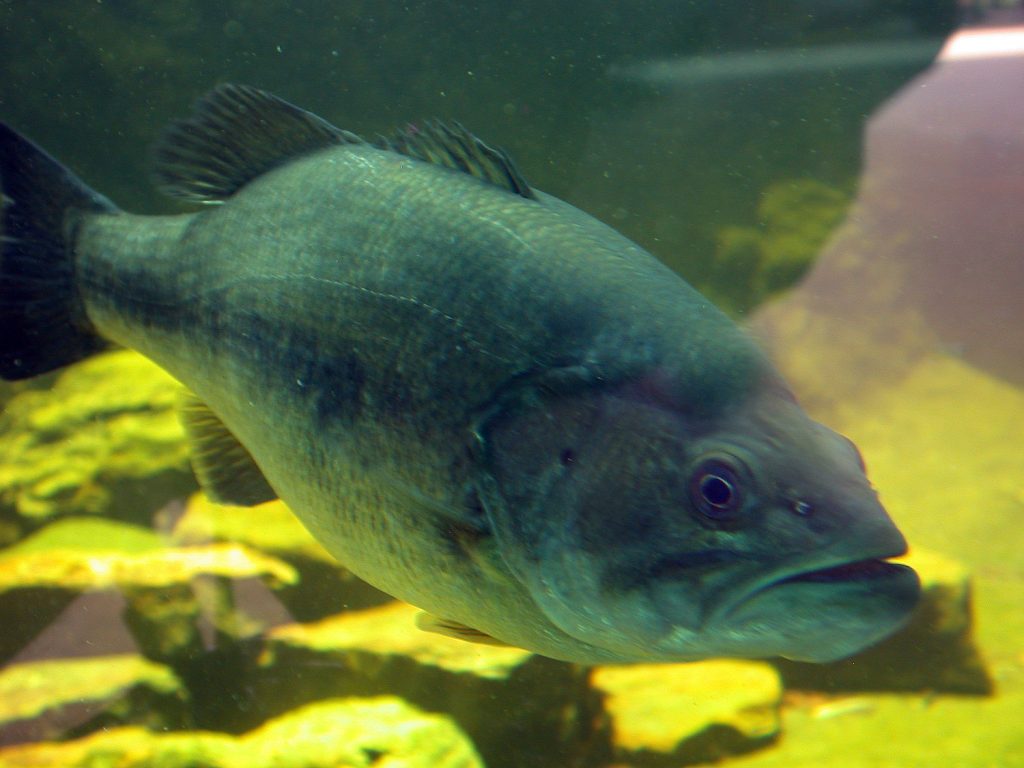
If you’re interested in learning more about fishing on the Black Warrior River and particular baits that local fishermen have found to be beneficial, you’ve come to the right spot!
Editor’s Note: Toby Wilson is a management consultant and has been fishing on the Black Warrior River in Tuscaloosa County for the last seven years. He’s also heavily involved with high-school bass fishing in Tuscaloosa County with his three sons through Holy Spirit High School. His eldest, Garrett, is 18-years old, his son, Matthew is 16-years old, and his youngest son, Chase, is 15-years old.
John E. Phillips: What size of lures are you using to catch bass on the lower end of Oliver Lake?
Toby Wilson: I prefer to fish either a 3/8-ounce or a 1/2-ounce chatterbait with a white skirt and a soft-plastic Rage Tail trailer. Occasionally, I’ll use a Z-Craw trailer as well.
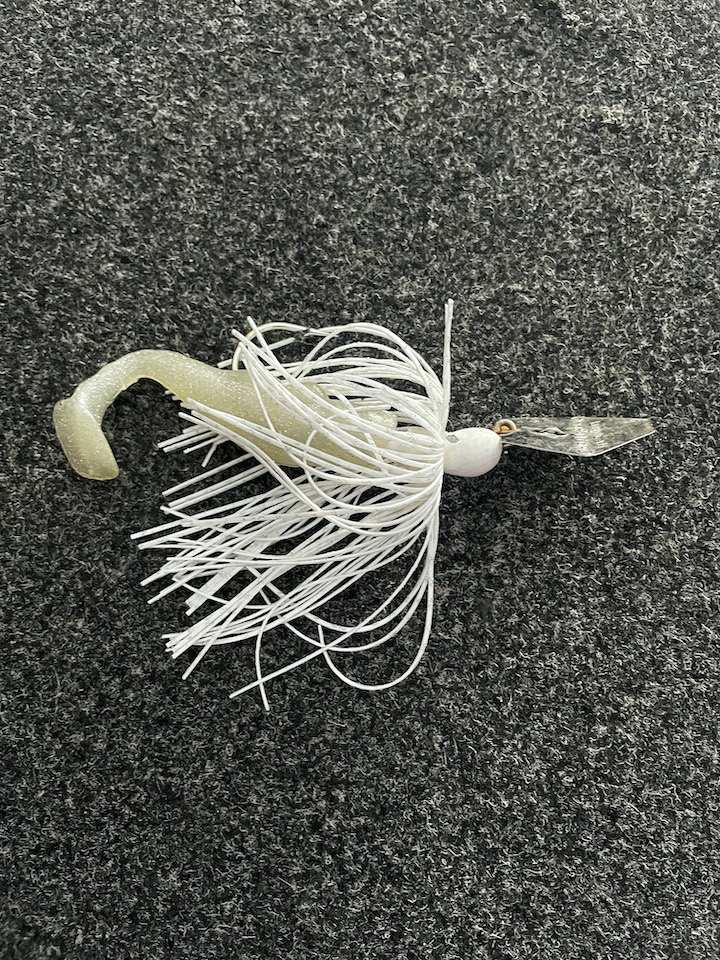
Phillips: How are you fishing the chatterbait?
Wilson: Often we’ll just cast and retrieve this lure. But there’s a lot of wood in Oliver’s backwater regions. We’ve found that banging the chatterbait up against logs in the water, fallen trees and any other type of wood may cause a bass to strike. Other times, we’ll fish the chatterbait slowly on the bottom. If the grass hasn’t grown-up to the surface, we’ll fish the chatterbait through the lily-pad stems, the grass stems and the underwater stumps. We want the chatterbait to hit the wood and trigger a reaction strike.
Phillips: The other lure you mentioned was a square-bill crankbait. Which is your favorite square-bill crankbait lure, and how are you fishing it?
Wilson: I use quite a few different manufacturers. I like Booyah, Bomber, Bill Norman and Lucky Craft. My boys and I fish a variety of assorted colors, such as white, sexy shad and blue back with chartreuse sides. We primarily fish bright colors that the bass can see in Oliver’s stained water.
Phillips: How are you working the square bills?
Wilson: We’re trying to crank the square bills and bounce them off the wood cover.
Phillips: Most people don’t like to run crankbaits through heavy wood cover because they’re afraid they’ll lose the crankbaits. How do you solve this problem?
Wilson: Some days you don’t lose any lures, and on some days you lose a lot. The best thing to do is bring numbers of crankbaits with you when you’re planning to fish the backwaters on Oliver Lake. We’ve learned that if we’re not banging the square bills into the wood, we don’t get as many strikes as we do when we crash the crankbaits into the wood cover off the main river channel.
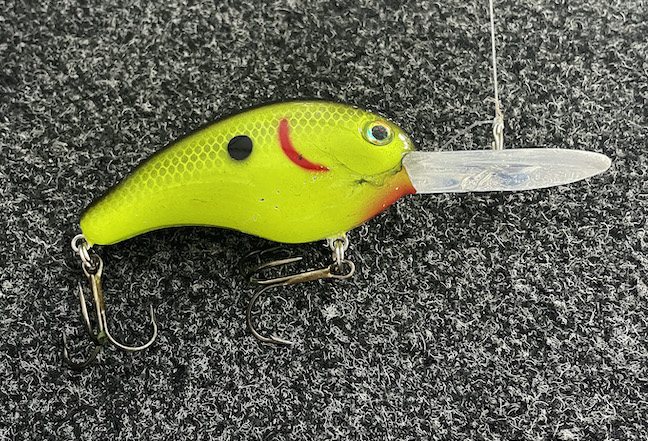
Phillips: Two effective ways to fish a crankbait through wood cover is to pause the crankbait as soon as it hits the cover or burn the crankbait through the cover. Which tactic do you think is the most-productive at Oliver?
Wilson: We let the bass tell us which retrieve they’ll bite the best.
Phillips: What size bass are you catching in the backwater areas, and how many are you catching?
Wilson: Most of the average bass we catch will weigh 1-1/2-pounds to 4 pounds. But, every so often, we will catch a 5 pounder.

Editor’s Note: Toby Wilson is a management consultant and has been fishing the Black Warrior River in Tuscaloosa County for the last seven years. He’s also heavily involved with high-school bass fishing in Tuscaloosa County with his three sons through Holy Spirit High School. His eldest, Garrett, is 18-years old, his son, Matthew is 16 years old, and his youngest son, Chase, is 15-years old.
John E. Phillips: Besides the backwaters on Oliver Lake, where else are you fishing for bass?
Toby Wilson: In the spring, the current generally will be very strong when the area receives a large amount of rain. We’ll often pull out to the main riverbank and fish downed trees. We look for current breaks and eddy pools caused by downed trees that have fallen into the river. To fish on the main river channel, you must keep the nose of your boat pointing upcurrent with your trolling motor. Sometimes you may have to fish with the current, if the current’s strong coming down the river.
One of the techniques we use is getting behind a treetop downstream from a blowndown tree, cast up to the eddy pool that’s created behind the blowdown and run our chatterbaits with the current, back to the boat. Most of the bass we catch will be caught out of these types of eddy holes. If we’re fishing at the end of a blowdown, we’ll fish with a spinner bait or a shallow-running crankbait, like a 1.5. Sometimes we can fish the chatterbait on the ends of those treetops. Most of the bass we catch at the ends of the blown-down trees are spotted bass, and in the eddy holes, we primarily catch largemouth bass. Many times, the spotted bass will school-up on the ends or the front sides of the blowdowns, and you can catch as many as you want to catch. However, you may go back to the same tree a week later and not get a bite.
Recently I took my youngest son, Chase, to practice for a tournament that was to be held on Oliver Lake. Although he prefers to play golf, he still will go and fish with me. I gave him a chartreuse crankbait to fish with, and we found two logs laying in the water. In-between the distance of the two logs, he caught three spotted bass for a total of 8 pounds. I went back to those two logs on tournament day, but the spotted bass had left. One thing you must remember about river fishing is that it’s always changing. The current will eat the dirt out of the riverbank and cause trees to fall-in and create current breaks. Also, trees that are in the water already, where you may have caught bass before, may get washed down the river. So, anytime you’re fishing a river, you’re usually looking for another place to fish than where you did the week before. At Oliver, we always fish various spots on the river until we reach Akron. Then we fish blowdowns located on both sides of the river there.
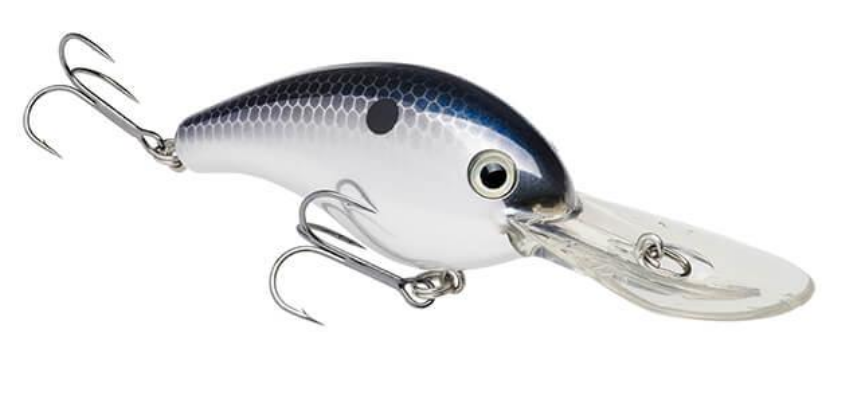
Phillips: What are your favorite Lake Oliver lures?
Wilson: My favorite river lures include a white spinner bait with white blades or a white spinner bait with gold willow-leaf blades. I use a white split-tail trailer on the back of the spinner bait. Sometimes I’ll have a big willow-leaf blade on the back of the shaft and a small willow-leaf blade on the front of the shaft of the spinner bait. I’ll also fish a combination of a gold Colorado blade with a gold willow-leaf blade on the same spinner bait. On bright days, the gold blades produce the best bass, and on overcast rainy days, the white-painted blades seem to be the best.
When we’re fishing spinner baits on the river, we know we’ll get hung-up often and even lose those lures. If you’re fishing near trees, bring numbers of spinner baits with you. We’ll fish the ends of the trees and the backsides of the trees. We’ll run the spinner bait through the trees and in the eddy pools behind the trees. If the spotted bass are around the trees, you can catch and release probably as many as you want.
We’ll also fish a medium-diving crankbait that dives 5-10 feet in chartreuse or in white colors and also a blue-back crankbait. Bomber, Bill Norman, Booyah and Lucky Craft crankbaits produce plenty of bass. I like the splatter back Bomber crankbaits. The river’s not very deep at Oliver Lake, although there may be some places deeper than 20 feet – but not many. Most of the bass we’re catching will be suspended and near logs.
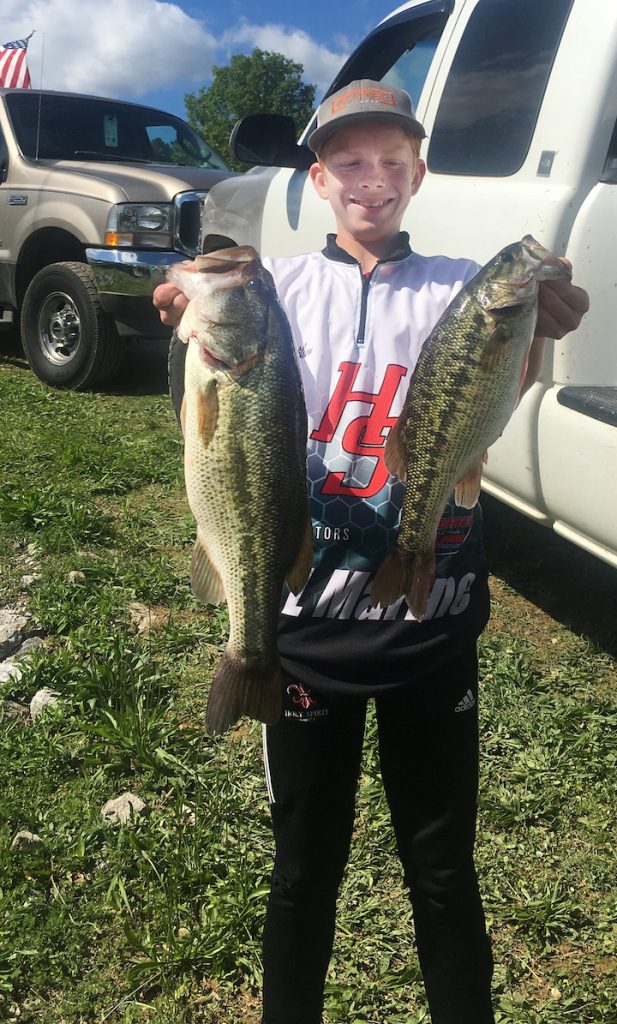
Phillips: Are you retrieving your crankbaits against the current, across the current or with the current?
Wilson: We always try and fish our crankbaits with the current, which means we must burn them hard as soon as they hit the water to get the crankbaits down to the depths where the bass are holding. We often will fish with a chatterbait as much as possible like we fish the crankbait. Oliver Lake’s water often is stained or muddy. So, having a lure like a chatterbait that makes a lot of noise may give you an advantage for catching bass there. Most of the time we’ll be using white chatterbaits, but on a cloudy, overcast day, we may fish a black-and-blue chatterbait.
Phillips: On a day of fishing the river around the logs and the blowdowns, how many bass do you think you’ll catch?
Wilson: If we’re fishing in a tournament, we know if we can get five bass that weigh 8-10 pounds, we’ll be in contention to win at Oliver. As far as the number of bass we can catch in a day, we may catch 20-30, if we can find the right tree top where the bass are holding. Most of the fish in treetops will weigh 1-1/2 to 2 pounds each. The best spotted bass my family ever has caught at Oliver weighed 4 pounds, and on most lakes, a 4-pound spotted bass is considered a good catch.
Phillips: If you fish on Oliver Lake down to Akron, where will you catch the most spotted bass and the most largemouths?
Wilson: We usually catch the most spotted bass upriver in Oliver, and most of our largemouth bass weighing 1-2 pounds each we catch in the backwaters close to Akron. In the backwaters, we have caught a limit of five bass weighing 12 pounds in a tournament. Many locals really do well fishing for largemouth bass in the backwaters. Often, the locals will catch five fish, weighing 15-20 pounds, in a day of bassing the backwaters.
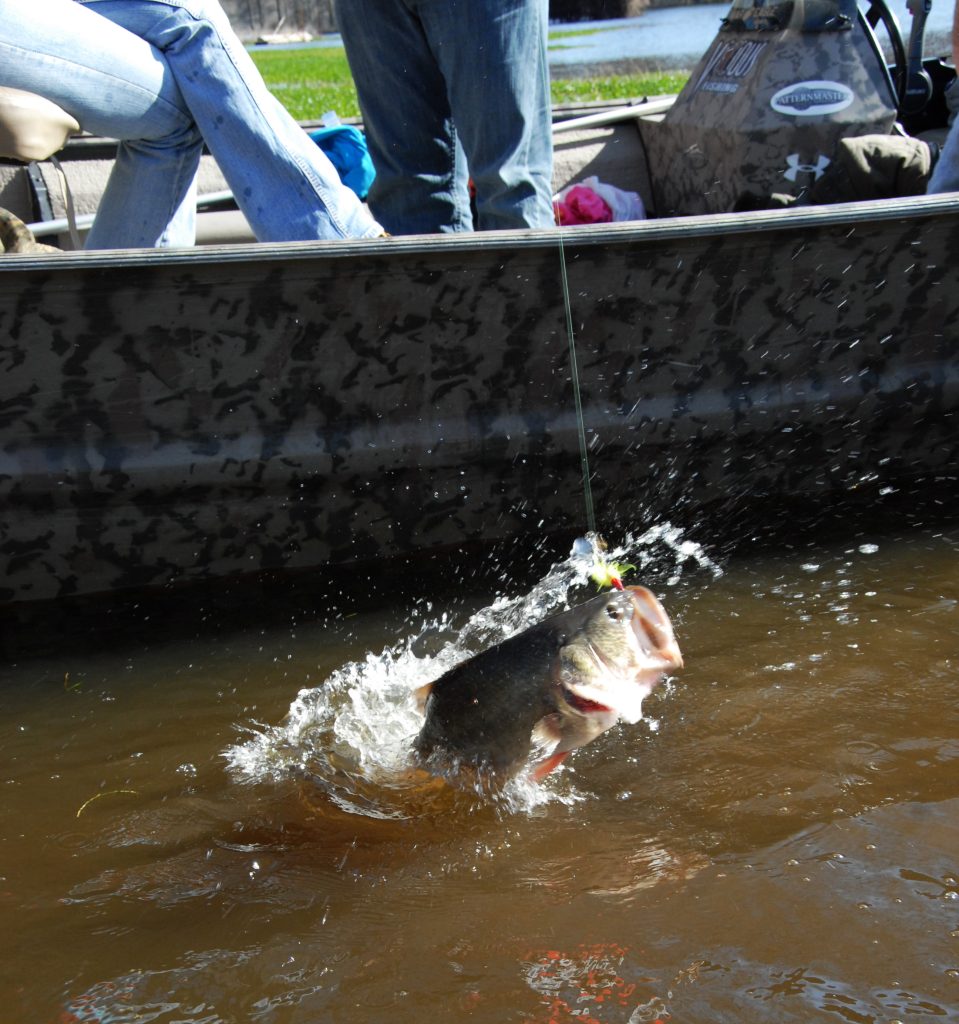
Unusual cold front doesn’t stop bass angler Adam Hollingsworth and Outdoor Writer David Rainer
Editor’s Note: On a spring trip to Holt Lake on the Black Warrior River in Tuscaloosa County, Adam Hollingsworth, captain of the University of Alabama’s Fishing Team, was guiding David Rainer with Alabama’s Department of Conservation went bass-fishing on the Black Warrior River. They weren’t able to get started until 9:00 am, so they missed the early-morning bite. However, perseverance and bulldog-type attitudes allowed them to find bass, get photos and enable Rainier to get his story on fishing this section of the Warrior River.
Adam Hollingsworth explains:
How the Bassing Day Started:
We put in at Rock Quarry Landing on Holt and went north all the way up to Lock 17 Dam, which is the tailrace of Bankhead Lock and Dam. We found a few bass holding in the grass, but we had a tough time catching those fish – even though we saw them on my Garmin LiveScope. I know many anglers don’t understand the value of LiveScope, but as a tournament fisherman, I’ve learned to use it to find bass and hopefully catch them. However, just because I can see them on LiveScope doesn’t mean those bass will bite. I much prefer to catch bass that I can see either with my eyes or electronics than to cast to spots where I only hope there’s a bass.
We tried fishing a point below the grass, but we didn’t see any bass or get any bites. We went across the lake and fished the rock wall there, where a current was being generated by the power plant. Because of recent rains, a strong current was coming out of the hydroelectric power plant, and I thought that the current might have moved the bass further down the lake. These places were where I’d caught bass before, and I strongly believed that we would catch bass there on this trip. But, since the water and bass conditions had changed, I knew we had to switch tactics to find the bass that day, instead of continuing to fish the sites where I’d caught bass upriver in the past.
We moved down to mid-lake and went past Davis Creek and around one of the bends before pinpointing a small point that turned into another creek. The creek didn’t have a name, but we went into it, and saw bass on my LiveScope and shad on which the bass were feeding. The water temperature was about 68 degrees in most places, and in some, it was 70 degrees.
We went to a little grassy spot further down the lake and had one bass follow my lure. But the fish wouldn’t bite it. I was fishing with a jig, while David Rainer was fishing with a spinner bait. I swam a jig down beside a log, and a bass then came out and followed my jig but stopped. Then that same bass came out from under that log and followed David’s spinner bait, tapped it but didn’t get it in its mouth.
How We Fished for Bass at Pegues Creek:
As we went back down the river toward Rock Quarry Landing, we spotted an area with a number of docks. I tried a jerkbait and several other lures but couldn’t get another bass bite. Therefore, we went down the river to Pegues Creek. The weather was really getting hot, so we pulled up to a dock where we had some shade, took a break, ate our lunch and did our interview. I told David, “We’re going to the back of this creek. Generally we can catch some bass there.”
We started fishing the back of Pegues Creek and spotted another angler who was fly fishing. He told us, “The bluegills are really hitting, but I haven’t caught a bass.” We noticed that the water there was cleaner than it had been on the river. We met yet another bass fisherman, who had spotted some bass in another section of the creek. He’d hooked a bass on the bed but didn’t land it. He said he had some bass following his swim jig that wouldn’t take it.
Next we went to the opposite side of the creek to keep from interfering with that angler’s fishing. I changed baits from using a white swim jig and/or a black-and-blue swim jig to a color that better imitated a bluegill. I went around a point headed to a secondary creek, and a bass took my bait around the rock wall bluff. Even though the bass only weighed about 1 pound, that fish told me that the bass were on a bluegill bite. I kept casting that bluegill-colored swimbait, and David continued to cast his spinner bait. We saw some big bass in Pegues Creek that were on the beds, but they just didn’t want to eat our baits. I had a few more bass follow my bait, and some smaller bass attacking it. I told David, “Let’s go fish some sand.”
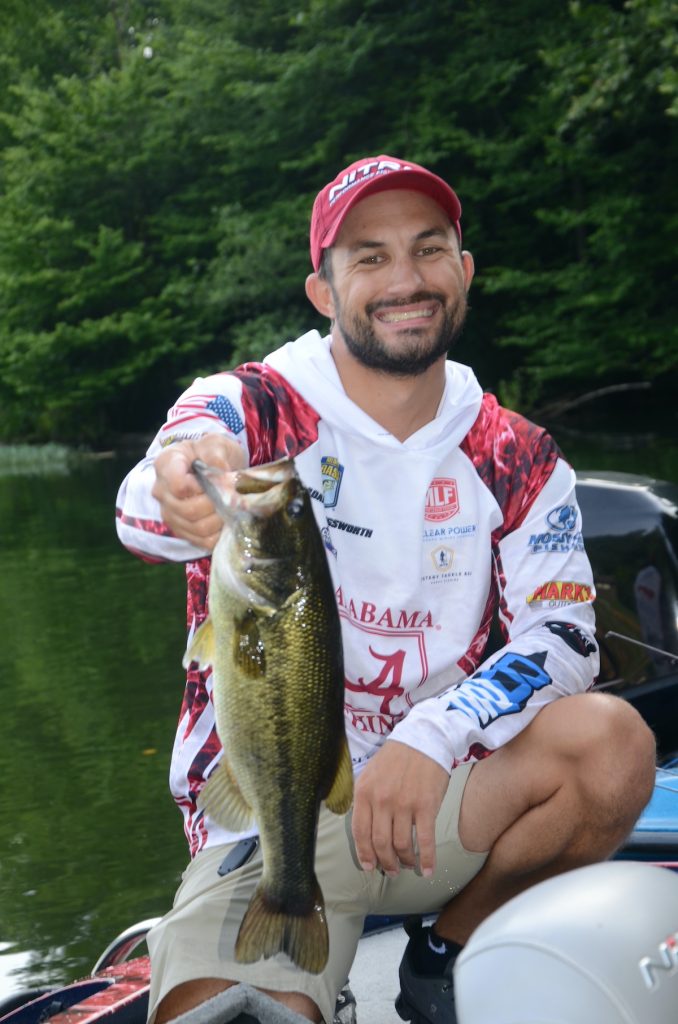
What We Learned at Redeye Creek:
We headed to Redeye Creek by turning left out of Pegues, going upriver toward Rock Quarry, and passing a little creek mouth where I always had success in finding and catching bass. This little creek is right at the coal chutes that bring the coal from the land and load it into the barges. This is a cold-water creek and has a little sandy shoal on it.
The first time I cast my jerkbait out, I caught a 2-pound, spotted bass. I used my LiveScope to scan that shoal and saw that there were several spotted bass holding in that area. Two casts later, I caught another spotted bass. We went to the back of this creek where the water was very shallow. Although I had bass following my jerkbait back to the boat, they wouldn’t attack the jerkbait.
What We Learned at Daniel Creek:
We came out of Pegues and went downriver to Daniel Creek to the Warrior Met Coal Barge Loadout. Although this little creek had been shallow in the past, as I looked at it with my sonar, it apparently had been dragged and was now deeper than it had been in the past. I cast my jerkbait into the mouth of the creek and used a jerk-jerk-pause type of retrieve. A bass drilled my jerkbait. I could tell it was a really-nice bass, but it pulled off my lure before I could get it in the boat.
We went some further, and I caught and landed a 3-1/2 pound spotted bass. I saw about two more of that same size following the one I’d just caught. Because we couldn’t get to the deeper depth quick enough, I decided to jerk the spot into the boat with my rod. However, it came off my hooks before I got it to the boat.
We continued back into Daniel Creek, and I had several good strikes. But a lot of debris had washed in from upriver. I changed lures to fish with a rubber frog. I had several bass blow-up on the frog and lost a little one.
What Happened at Eagle Cove Marina:
Next we left Daniel Creek, returned to Rock Quarry Landing and turned into Eagle Cove Marina, which is just past Rocky Branch, going upriver. The water was very-stained, and there was a lot of debris on the surface. So, I couldn’t see any bass. David said, “We’ve had a good day, we’ve caught a few bass, we’ve lost more bass, and I’ve got a good story and good photos. Let’s call it a day.”
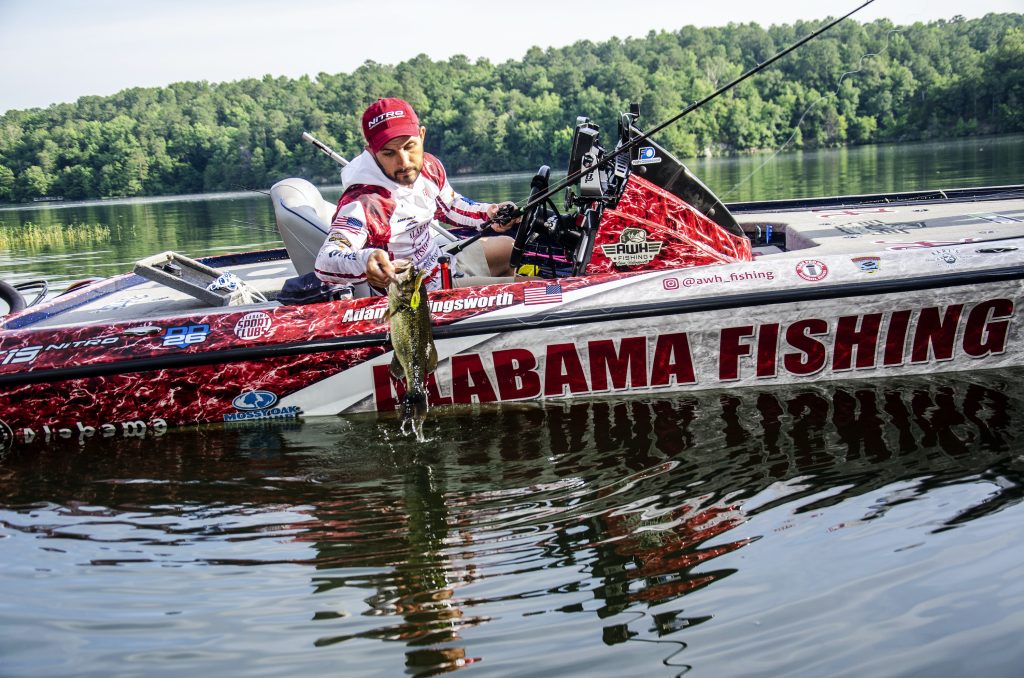
Interested in fishing in Tuscaloosa County? Longtime fisherman and native to the area, Dalton Bobo, shares insights and tips to springtime bass fishing in Tuscaloosa County.
Editor’s Note: Dalton Bobo, longtime resident of Northport, Alabama, rose to nationwide bass-fishing fame at the 1997 Bassmaster Classic held on Logan Martin Lake near Birmingham, Ala. On the final day, Bobo went to the scales with the winning bag of bass. But before Bobo’s limit of bass was weighed, the officials determined that one of his bass had died and imposed a 4-ounce penalty that was deducted from his total fish weight. He lost the Classic by 1 ounce and its $100,000 prize. However, that loss catapulted Bobo to a 14-year professional bass-fishing career, after which he guided for several years on the Black Warrior River in Tuscaloosa County.
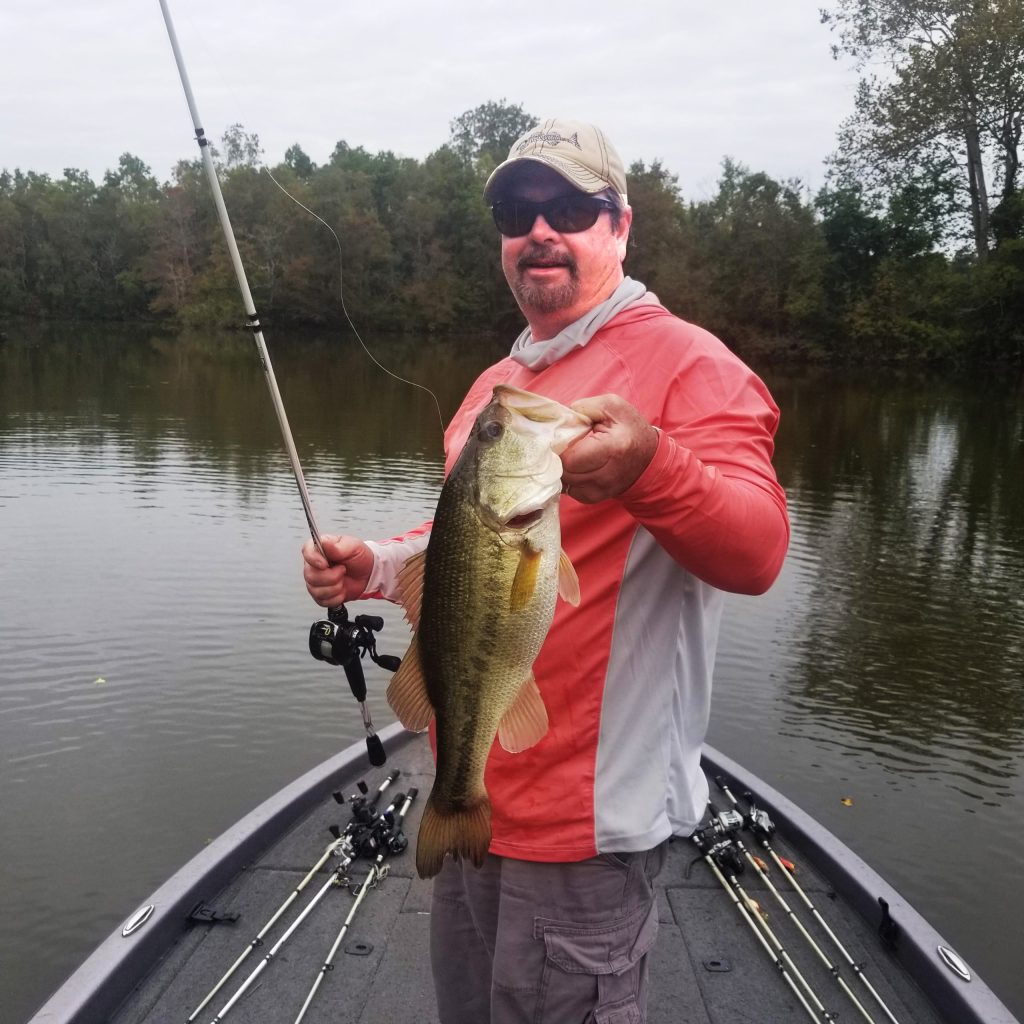
Tuscaloosa’s Warrior River – The Best Place Bobo says to Train Tournament Bass Fishermen:
I enjoy fishing the Warrior River from below Lock 17 – the Holt Reservoir – all the way downriver. This section of the Warrior River can prepare a tournament fisherman for almost any type of water a bass angler may compete on, and I’ve fished here all my life.
What most people don’t realize is that the Black Warrior River in Tuscaloosa County is a very-diverse fishery. Bankhead Lake (the reservoir above Lock 17) and Holt Lake (below Lock 17) on the River both can be considered highland-reservoir types of lakes or mountain lakes. Numerous creeks run into Bankhead and Holt, and many hollows dump fresh water into the Black Warrior River system after a rain. These two lakes are in the foothills of the Appalachian Mountains. They’re fed by the Mulberry Fork and the Locust Fork that come together to create the Black Warrior River. The lower end of Holt Reservoir is almost in the city limits of Tuscaloosa. When you leave Holt Lake and go downriver, you’re moving into Oliver Lake, which is more of a coastal plains kind of lake. The Black Warrior from Tuscaloosa south is a lowland type of river.
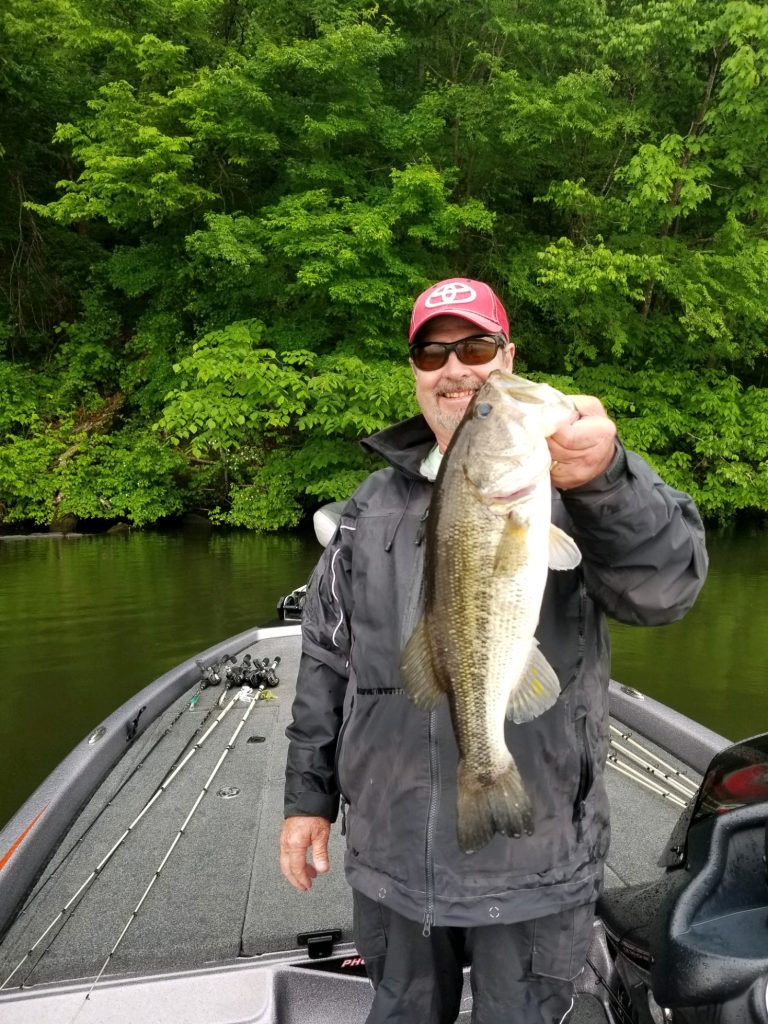
If a tournament angler learns to fish the upper lakes (Bankhead and Holt) of the Warrior River in Tuscaloosa County, he’ll become schooled on how to fish highland reservoir types of lakes. If next he goes to just below the city of Tuscaloosa to the Oliver pool, he’ll learn how to fish lowland lakes. The water at Oliver is more dingy, often contains a lot of stain and color and has natural creeks and oxbow lakes and sloughs coming off its main river channel.
Here in Tuscaloosa and Northport, Ala., we have one of the most-diverse fisheries anywhere in the nation. Also, in the upper portion of Bankhead Reservoir is Smith Lake Dam that backs up to Smith Lake – a big, clear, deep highland reservoir that feeds into the Black Warrior River. Because the water is pulled from the bottom of Smith Lake, even if the Tuscaloosa area has giant rains, the water can be gin clear above Bankhead Lock and Dam and the headwaters of Holt Reservoir. In fishing Tuscaloosa County, there’s enough diversity to help train any tournament fisherman to fish a wide variety of water.
Bankhead and Holt Reservoirs Grow Big Bass:
To catch big bass, both Bankhead and Holt reservoirs in Tuscaloosa’s Black Warrior River are where you can get your string stretched and make the drag on your reel squeal. These two impoundments have blueback herring in them that they’ve never had before. The blueback herring – a large forage fish – has helped to grow bass bigger and quicker than they’ve grown in the past, while feeding primarily on threadfish shad and bluegills.
Three years ago, most bass tournaments held on these two lakes would be won by a five-bass limit of 16-17 pounds. Now, three years later, a five-fish limit of 23-24 pounds of bass is needed to win a tournament at either lake. The big bass caught in any tournament there could weigh 9-10 pounds. For tournament fishermen who keep up with the stats on lakes and the tournament online, they know to even have a chance at winning, they’ll have to have upwards of a five-fish limit of 25 pounds. And, if you expect to catch the big fish of the tournament, that big bass will have to weigh 8+ pounds. I really believe that the blueback herring that have been introduced to the lake is the main reason for the growth of the bass in those two reservoirs in the northern part of Tuscaloosa County.
A good number of saltwater stripers and hybrid striped bass live in Bankhead and Holt reservoirs too that definitely will bow your rod, stretch your string and make your reel sound like a siren going off when those big fish pull the drag so fast off your reel.
Lake Tuscaloosa:
Lake Tuscaloosa is a water-source lake for the cities of Tuscaloosa and Northport. Spotted bass, largemouth bass and some good-sized crappie fish live there. But the bass population and the size of those bass is declining.
Oliver Reservoir:
Below Holt in Tuscaloosa County is Oliver Reservoir that’s more of a riverine kind of lake with little backwater and feeder creeks. Some 6-8 pound spotted bass have been weighed in at Oliver Lake during tournaments. When you leave Tuscaloosa and go downriver, for about 40 miles is typical river habitat with laid-down trees, stumps and grass, making Oliver one of my favorite places to fish for bass. Sandbars on Oliver are where the bass often tend to congregate. You can have a really fun day of bass fishing on this downriver stretch of the Black Warrior River below the city of Tuscaloosa. I catch about as many largemouths on this section of the river, as I do spotted bass.
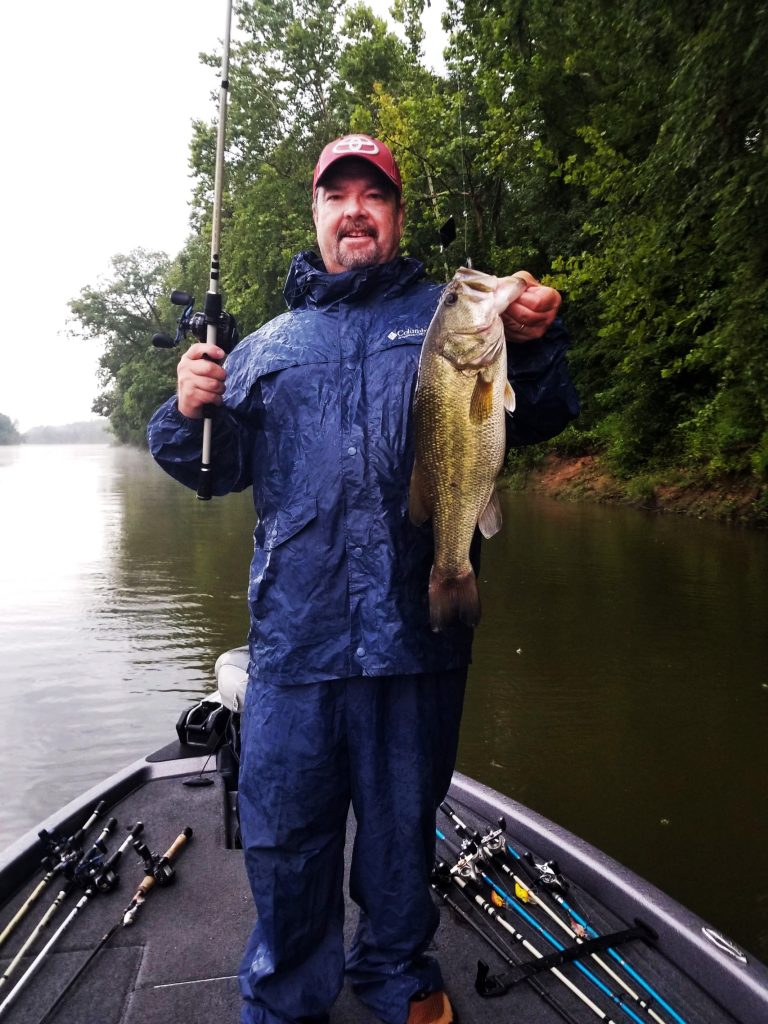
Below that 40-mile mark, you’ll start finding creeks, backwater sloughs and numbers of cypress sloughs that hold good numbers of bass. On that lower end of the Black Warrior River from Akron to Demopolis, you’ll find more sloughs and backwaters than are in that first 40 miles below Tuscaloosa.
Pluses for Bass Fishing at Bankhead, Holt and Oliver Lakes:
One of the plusses for bass fishing here in Tuscaloosa County is that you don’t have to drive very far in a boat or a car from the cities of Tuscaloosa and Northport to experience some really-good bass fishing. All three reservoirs have some water generation (current) flowing through them, especially in the spring and summer. Current tends to make bass bite better. If you lock-up from the Oliver pool that’s in the City of Tuscaloosa, you have about a 17-mile-long body of water in Holt Reservoir with plenty of creeks and hollows and natural runoffs where bass tend to hold, besides on the main river system.
Then you’ll go into Bankhead. If you have a good day, and the bass are really biting, you may catch 40 or 50 fish – not on every day, but on many days. An average day will be catching 17 to 25 bass.
To catch some of the biggest bass in the Warrior River, fish in April. As the weather begins to warm up and the big momma bass are migrating to the banks, spinnerbaits and chatterbaits may produce a 7-9-pound bass for you. The last time I fished at Bankhead, I caught an 8-pound, 9-ounce bass.
